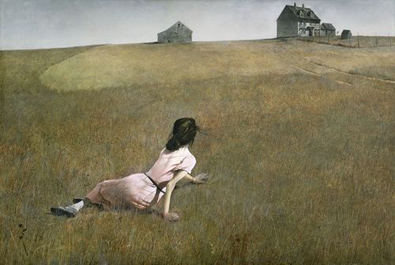 Andrew Wyeth's painting Christina's World, the subject of A Piece of the World, was initially met with little fanfare, and its critical reception was lackluster. Nevertheless, the painting, which features Christina Olson reaching toward her home in the distance, was purchased during its first showing at a New York Gallery in 1948 by Alfred Barr, the founding director of the Museum of Modern Art (MoMA). Today it is one of MoMA's most admired exhibits and has become a well-known representation of American art. The painting has been loaned out only once since its purchase when it was shown for two days in 2009 at Chadds Ford, PA, Wyeth's hometown, in memoriam of the artist.
Andrew Wyeth's painting Christina's World, the subject of A Piece of the World, was initially met with little fanfare, and its critical reception was lackluster. Nevertheless, the painting, which features Christina Olson reaching toward her home in the distance, was purchased during its first showing at a New York Gallery in 1948 by Alfred Barr, the founding director of the Museum of Modern Art (MoMA). Today it is one of MoMA's most admired exhibits and has become a well-known representation of American art. The painting has been loaned out only once since its purchase when it was shown for two days in 2009 at Chadds Ford, PA, Wyeth's hometown, in memoriam of the artist.
The Olson House, which is featured in many of Wyeth's paintings, was originally constructed in the late 1700s by Alexander Hathorn to replace a log cabin built by his father. Several generations of Hathorns lived there and transformed the surrounding land into a profitable farm. The house was modified and expanded over time, eventually reaching its current size of 14 bedrooms. It was a popular summer destination for nearly two decades from 1872 to 1890, with rooms available to rent to those wishing to escape the heat for the cooler weather of coastal Maine.
In 1892, the St. George River froze, forcing a young sailor by the name of John Olson to take shelter at the Hathorn homestead. There he encountered Katie Hathorn and her mother, the last two surviving members of the family. John and Katie married and raised their four children on the premises, two of whom, Christina and her younger brother Alvaro, inherited the property and continued to reside there throughout their lives.
Andrew Wyeth was introduced to the house and its residents by his wife, Betsy, who was an acquaintance of the siblings. Wyeth formed a close bond with Christina and Alvaro to the point where he was welcome to come into the home at any time and use one of its rooms as a studio. Over 300 works were created in the house, many of which featured the Olson House itself as the subject. According to Wyeth, "In the portraits of that house, the windows are eyes or pieces of the soul almost. To me, each window is a different part of Christina's life." Betsy described it as "looming up like a weathered ship stranded on a hilltop."
After Christina's death in 1968, the house was purchased by movie director Joseph E. Levine (The Lion in Winter, The Graduate). Levine, who was a fan of Wyeth's, tried to operate the Olson House as a museum in 1971-1973 but was met by local opposition and never could get the enterprise off the ground. It was eventually purchased by Apple CEO John Sculley in 1986, who attempted to sell it three years later. When he could not find a buyer he donated the house to the Farnsworth Art Museum in 1991. It was placed on the National Register of Historic Places in 1995 and named a National Historic Landmark in 2011.
The Farnsworth Art Museum describes its purpose as "Celebrating Maine's Role in American Art." It restored the Olson House so that its appearance matches Wyeth's paintings, and then opened it up to the public. They currently advertise a "Wyeth Experience" tour, which starts with an in-depth look at the Wyeth paintings housed in the main museum in Rockville, followed by a van trip through the Maine countryside past landmarks that appear in Wyeth's paintings, culminating with a tour of the Olson House and its grounds.
Every time BookBrowse reviews a book we go "beyond the book" to explore a related topic, such as the article above for A Piece of the World by Christina Baker Kline. Most of these articles are only available to our members, but at any given time, a sampling can be found on our homepage and, from time to time, we reprint an article in this blog.
Fair use image of Christina's World.